The Wonga Wonga vine ( Pandorea pandorana ) is a fast growing climbing plant which is native to Australia and parts of the South-western Pacific region. It produces masses of flowers in Spring as the warmer weather starts. There are several colours available including yellow'/gold, pink, and white /creamy white. The plant can be utilized as an attractive screen for privacy when grown over a trellis or maybe to cover a wall. It grows best when in full sun , but it will tolerate light shade, and it is very hardy and fairly drought tolerant once established. One plant can grow quite large, easily covering say a 3m x 3m area of support. In the wild, it scrambles over other vegetation and climbs up other trees and shrubs. Suited to frost-free temperate and warmer climates.
I photographed this Pandorea plant in a reserve on Sydney Harbour.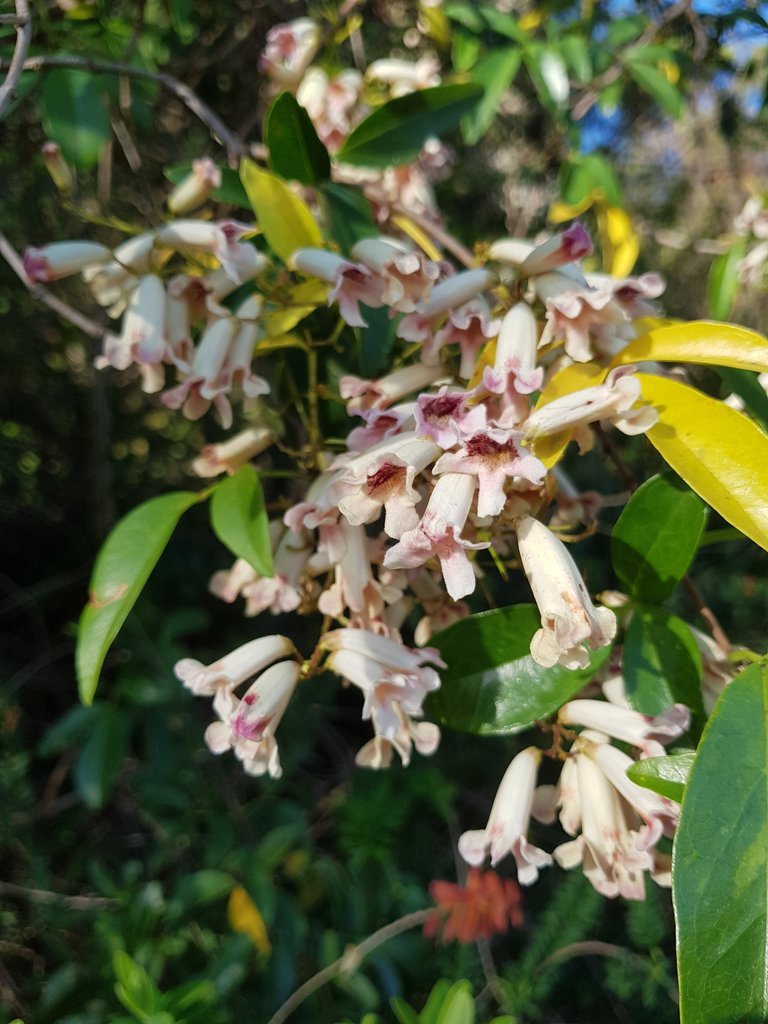
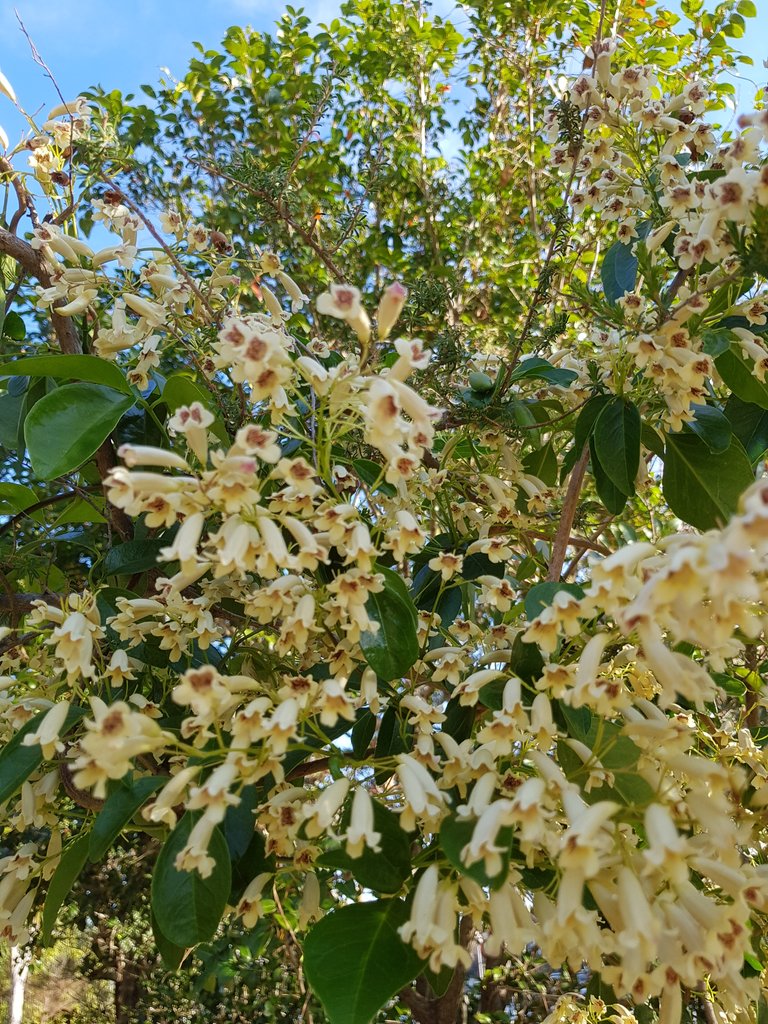

A variable native climber with twining branches and glossy green foliage, it flowers from winter to summer. It has masses of pendulous bell flowers, which are variable in colour, from pure white, cream with purple-maroon veining through to yellows. It is a fast growing plant, suitable for tropical to temperate regions. It will tolerate light frosts. Good for sun to part shade, and adaptable to most soils as long as they have reasonable drainage. Can be cut back hard to rejuvenate. A good butterfly food plant.
https://www.gardeningwithangus.com.au/pandorea-pandorana-wonga-wonga-vine/
Fav. comment Award !! Beautiful Pics .
Thank you sir.
Pandorea pandorana, Wonga Vine, is a member of the Bignoniaceae family. This woody scrambler or climber has long, twining branches with fawn coloured bark.
The leaves are pinnate with from three to seven leaflets up to 15 centimetres long. Juvenile leaves have small, numerous leaflets giving plants, at this stage, a ferny appearance.
Flowers are tubular, about two centimetres long, usually creamy-white with either brown or purple markings in the throat. Flowering is both profuse and conspicious in spring. The floral display is particularly eye-catching because the blooms are held in large terminal clusters.
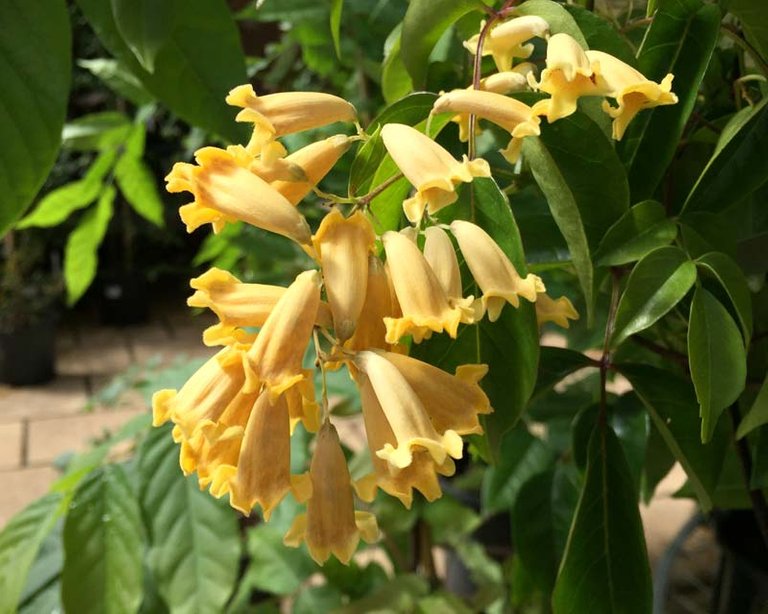
The capsules, that follow the flowers, are oblong; tapering at both ends and contain a number of winged seeds.
There are a number of colour forms: “Snowbells” has pure white flowers and “Golden Showers” with distinctive yellow-bronze blooms are well known.
“Golden Showers” is a particularly interesting form. It comes from the forest country, west of Kempsey, northern NSW. Many years ago trip by the Armidale Group of APS came across this form in the forested country, east of Armidale. Not so long ago a researcher, from the University of New England, also came across the form in the same area. Some cuttings were collected and “Golden Shower” is growing happily in our garden.
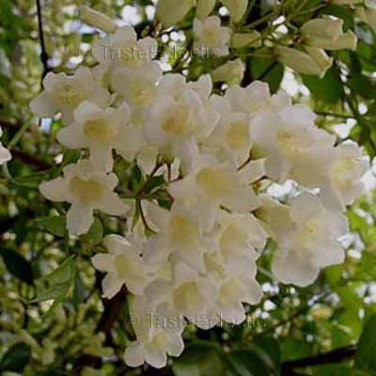
P. pandorana is widespread in eastern Australia from Cape York to southern Victoria. There are also occurrences on Flinders Island in Bass Strait and in central Australia.
Propagate from seed and cuttings. Colour forms should be propagated from cuttings to maintain the flower colour.
 https://austplants.com.au/Pandorea-pandorana-Wonga-Vine
https://austplants.com.au/Pandorea-pandorana-Wonga-Vine
Silly Sausage Award !! Great choice of Pics.
Thank you....
Shared on twitter promoting good quality content on #Steemit. Stephen
#Promo-Steem #steemtalent #JoinSteemit #Steemit
Wonga Wonga Vine. #STEEM #steemtalent #JoinSteemit #Steemit @Steemit
#GardenersWorld #Gardening #Australia #Blogger #Photographer
An easy to grow strong and vigorous, evergreen Australian native climber with pointed dark glossy green foliage, and clusters of showy bell shaped cream flowers with speckled maroon throats. It is suited to a wide range of conditions and soil types from sandy to clay. But best in fertile, compost rich, free draining soil in full sun to light shade. Prune after flowering to shape.
An easy to grow strong and vigorous, evergreen Australian native climber
Clusters of showy bell shaped cream flowers in spring
Suited to a wide range of conditions and soil types from sandy to clay.
Will climb through other native plants
Drought tolerant once established
https://www.bunnings.com.au/140mm-wonga-wonga-vine-pandorea-pandorana_p3640674
I see this plant has vivid color flowers! It looks so great and I like that scenery of the footpath! I like this photography and the description!@ctrl-alt-nwo,
Cheers~
Yeah, this is the Reserve i try to walk every week. It's a 5km walk, but it is so nice there beside the Harbour with nice bush around. The land is cared for by volunteers who keep the bushland free of weeds etc for us and the wildlife to enjoy.
I wish you might show us more photography of this foot path! Actually it looks very clean and amazing!@ctrl-alt-nwo,
Cheers~
It looks very nice smells. It should be so nice to walk between them:)
Glossy oval leaved, evergreen vine doing best in warmer climates or very protected areas. More vigorous than Pandora jasminoides, plant where this has ample room to climb. Spring flowers are yellow to pinkish white, dotted with purple throats. Prune tips of vine back several inches after bloom. Requires some shade in hotter areas.
Most plants like 1 inch of water a week during the growing season, but take care not to over water. The first two years after a plant is installed, regular watering is important for establishment. The first year is critical. It is better to water once a week and water deeply, than to water frequently for a few minutes.
Source: https://www.backyardgardener.com/plantname/pandorea-pandorana-wonga-wonga-vine/
Pandorea pandorana is a fast-growing highly variable species of a woody climbing vine, it is found across continental Australia, Indonesia, Papua New Guinea, the Solomon Islands, New Caledonia and Vanuatu. In New Zealand, the species has become naturalised within disturbed native vegetation growing on larger trees in forested habitats.
It has glossy green leaves arranged oppositely along the stem. The pinnate leaves are around 8–16 cm long and have 3–9 leaflets of varying widths. The juvenile leaves are finer and have serrated margins and more finely divided into 7–13 leaflets.
Flowering occurs in spring. The tubular or funnel-shaped flowers are highly variable in colour, ranging from cream-white or all-white to maroon-throated, burgundy or even yellow-orange. Flowering is followed in summer by 3–8 cm long and 1–2 cm wide oblong-shaped seed pods, which are initially bright green before turning brown and releasing numerous papery seeds around 1-1.5 cm (0.5 in) in diameter which is released in large quantities.
source= http://www.terrain.net.nz/friends-of-te-henui-group/weeds/pandorea-pandorana-wonga-wonga-vine.html
Pandorea pandorana, the Wonga-wonga vine, is a member of the Bignoniaceae family. It is a vigorous woody climber found over an extensive area of eastern Australia in many differing environments. While more usually associated with moist forest habitats, it is also found in sandy soils close to the coast, in richer loams of volcanic origin, rocky situations in drier areas, and rainforest verges. It is often a persistent species in disturbed or cleared areas.
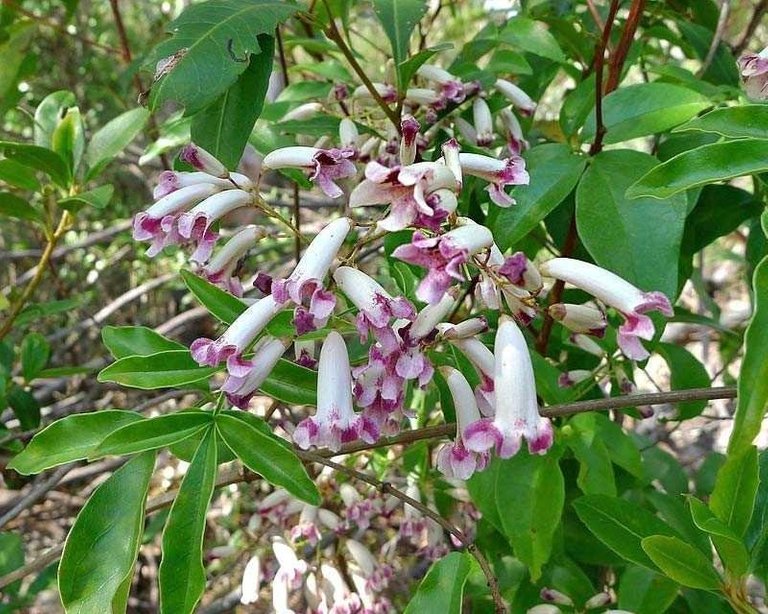
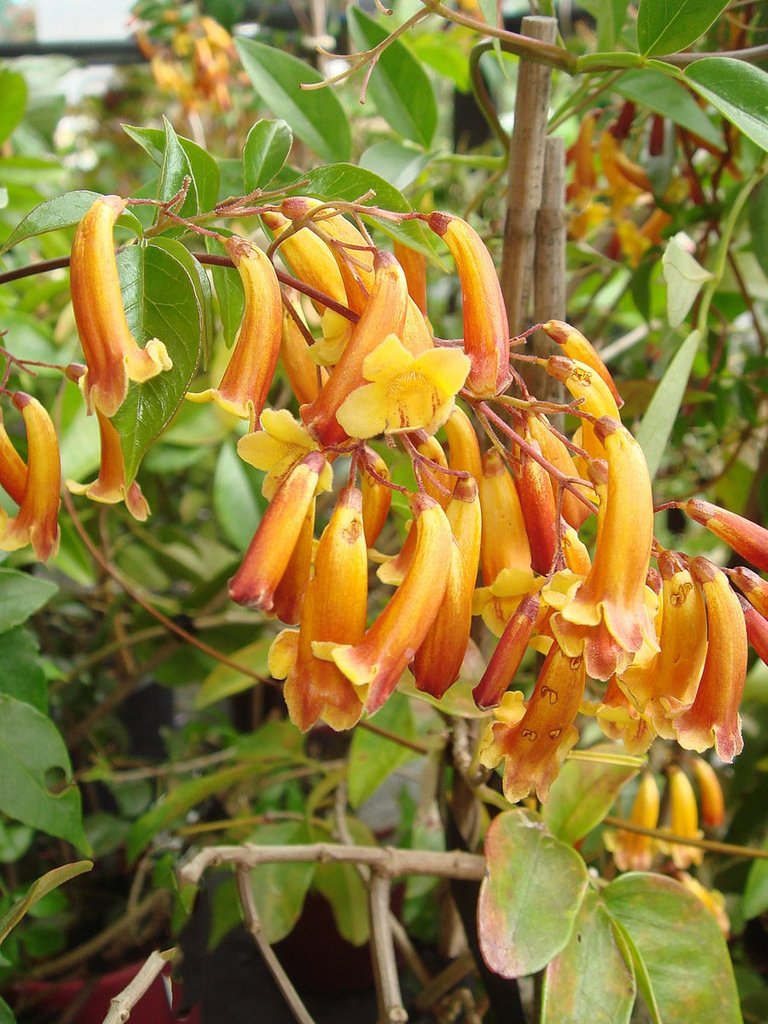
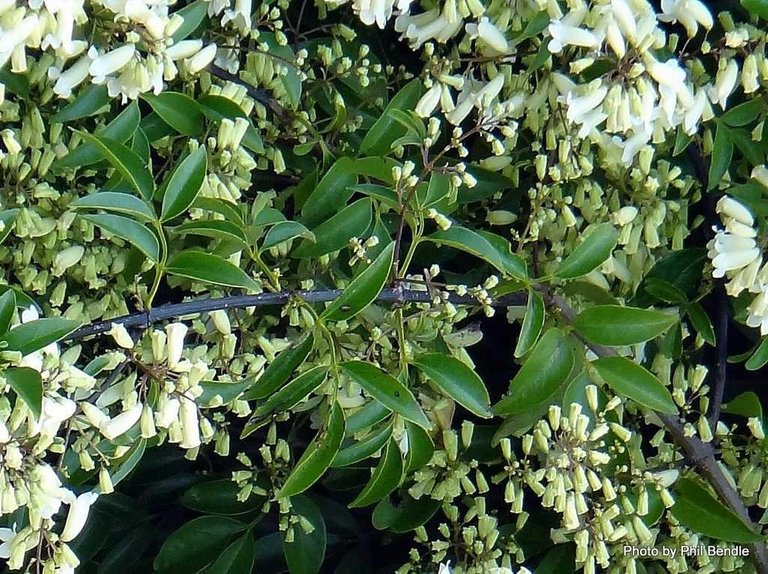
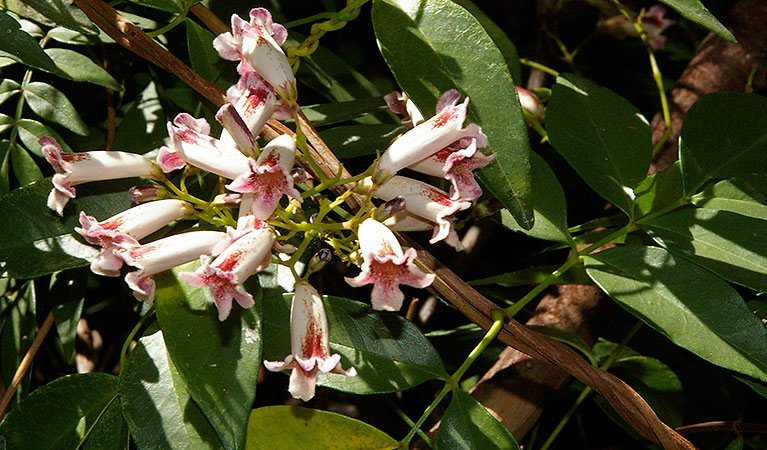
source of image
In forest conditions the plant may be difficult to see. It grows rapidly into the canopy and quite often the only indication of its presence will be liana vines reaching into the canopy and, during spring, the fallen flowers littering the forest floor. In more open forests it is a prominent species scrambling through the undershrubs. The leaves are easily distinguished, being pinnate and very glossy. An individual leaf consists of from five to nine leaflets that are ovate in shape and from 7 to 8 cm long.
source of image
spring the massed tubular flowers are very conspicuous. They can vary from white or cream to brown and often have maroon or purple striations in the throat of each blossom.
source of image
Seed is formed in a pod-like capsule from 4 to 7 cm long. The capsule opens to reveal copious quantities of flattened seeds, each one with a membranous, encircling 'wing'.
source of image
The original selection of Pandorea 'Golden Showers' was made by the Australian National Botanic Gardens from a naturally occurring plant of Pandorea pandorana growing near Kempsey in New South Wales in 1967. The cultivar name 'Golden Showers' refers to the golden-brown pendulous inflorescences. This cultivar will tolerate light frosts but could not be regarded as frost-hardy. If grown in cold environments it would require some protection, either by careful siting in protected positions near buildings or under a protecting plant canopy. It would be difficult to establish in 'frost hollows' where cold winter air has a tendency to pool.
source of content
It is interesting to see it. In the second photo I see this plant in the form of a tree. How does it wind, or crawl on other trees? Probably a good honey plant. Flowers have such a shape that they simply invite a bee.
It twines its way up the stems and branches of other plants.
Pandorea pandorana, the Wonga-wonga vine, is a member of the Bignoniaceae family. It is a vigorous woody climber found over an extensive area of eastern Australia in many differing environments.
While more usually associated with moist forest habitats, it is also found in sandy soils close to the coast, in richer loams of volcanic origin, rocky situations in drier areas, and rainforest verges. It is often a persistent species in disturbed or cleared areas.
In forest conditions the plant may be difficult to see. It grows rapidly into the canopy and quite often the only indication of its presence will be liana vines reaching into the canopy and, during spring, the fallen flowers littering the forest floor. In more open forests it is a prominent species scrambling through the undershrubs.

The leaves are easily distinguished, being pinnate and very glossy. An individual leaf consists of from five to nine leaflets that are ovate in shape and from 7 to 8 cm long.
In spring the massed tubular flowers are very conspicuous. They can vary from white or cream to brown and often have maroon or purple striations in the throat of each blossom.
Seed is formed in a pod-like capsule from 4 to 7 cm long. The capsule opens to reveal copious quantities of flattened seeds, each one with a membranous, encircling 'wing'.
The original selection of Pandorea 'Golden Showers' was made by the Australian National Botanic Gardens from a naturally occurring plant of Pandorea pandorana growing near Kempsey in New South Wales in 1967. The cultivar name 'Golden Showers' refers to the golden-brown pendulous inflorescences. This cultivar will tolerate light frosts but could not be regarded as frost-hardy. If grown in cold environments it would require some protection, either by careful siting in protected positions near buildings or under a protecting plant canopy. It would be difficult to establish in 'frost hollows' where cold winter air has a tendency to pool.
source
If the winter period of colder weather has left you and your garden feeling a bit worse for wear, you could be excused for hiding in the conservatory or greenhouse while Spring gets things back on course.
I find that several of my favourite spring flowering climbers came originally from Australia. Evergreen, they will all grow outside on a warm sunny wall in Cornish, coastal and urban gardens, but would, I suspect, have their flowering damaged some years by the frosts. However, even in an unheated conservatory it is business as usual.
The first to flower is a plant the Australians call "the native Wisteria", Hardenbergia violacea. This is an evergreen twiner that has bunches of very pretty violet blue flowers very early in the year. Easy to grow in the ground or in pots, it has handsome long leaves and can be allowed to twine through other plants. Although it requires a leap of imagination to see it as a "Wisteria" it is a very dainty climber.
undefined
Next up, is a relative of Hardenbergia called Kennedia. There are a number of different Kennedia species, but the one I find is best in spring is Kennedia rubricunda. The Australians call several of these different Kennedia "Running Postmen" after the old style red uniforms worn by their postal workers and the habit of the plants to sprout up quickly and climb, and as soon as you see the flowers, which are a bit pea-like, and in shades of red, you can see why.

The spring flower display is usually followed by furry pea-like seedpods. Again this is not a huge plant and can be accommodated in pots as well as the ground.
undefined
My third choice for spring under glass is one of the Pandorea species, Pandorea pandorana, the "Wonga-Wonga vine". The masses of cream-white, foxglove shaped flowers are delightfully marked inside with pink and have a light and pleasant fragrance
source
Pandorea pandorana is a fast-growing highly variable species of a woody climbing vine, it is found across continental Australia, Indonesia, Papua New Guinea, the Solomon Islands, New Caledonia and Vanuatu. In New Zealand, the species has become naturalised within disturbed native vegetation growing on larger trees in forested habitats.

sources
source
Thanks sir @ctrl-alt-nwo for always sharing beautiful plants.
Pandorea pandorana is a fast-growing highly variable species of a woody climbing vine, it is found across continental Australia, Indonesia, Papua New Guinea, the Solomon Islands, New Caledonia and Vanuatu. In New Zealand, the species has become naturalised within disturbed native vegetation growing on larger trees in forested habitats.
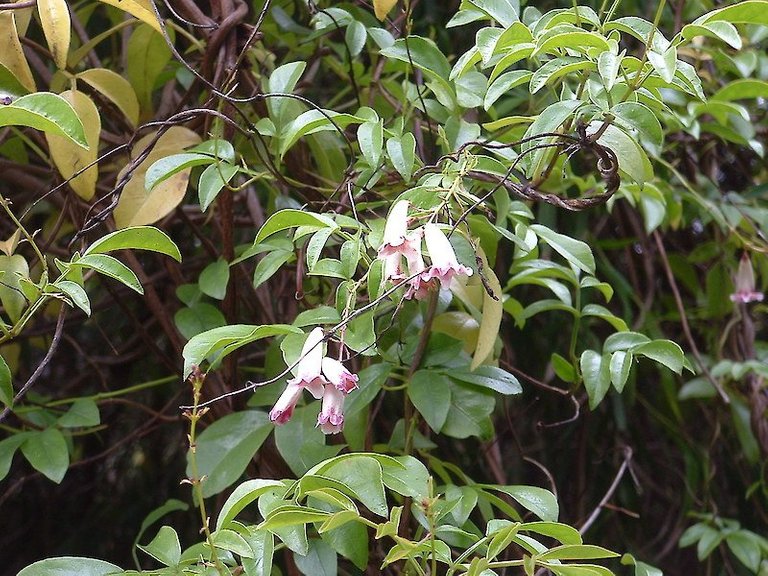

image source
source
Flowering occurs in spring. The tubular or funnel-shaped flowers are highly variable in colour, ranging from cream-white or all-white to maroon-throated, burgundy or even yellow-orange. Flowering is followed in summer by 3–8 cm long and 1–2 cm wide oblong-shaped seed pods, which are initially bright green before turning brown and releasing numerous papery seeds around 1-1.5 cm (0.5 in) in diameter which is released in large quantities.
source
It would be nicer if we could eat these flowers as well!!
Posted using Partiko iOS
For me, this is a novelty from Australia! Thank you for the wonderful plant!
Pandorea pandorana Ruby Belle is a flowering liana originally from Eastern Australia. Pandorea pandorana usually lives in wet forests, but it also occurs in a drier environment on sandy and loamy soils. It is also found on Flinders Island and in Central Australia.
It is a fast-growing liana with large feathery leaves resembling a leaf of a fern. It blooms mostly in spring, but can re-bloom in the summer. Flowers are tubular, about 20 mm long rare for Pandorea in red with burgundy tints.
Pandorea pandorana is very hardy in temperate climates, although it can be damaged by frost in very cold winters. It adapts to any drained soil and will grow in full sun or in partial shade. It prefers good watering, but adult plants can tolerate long dry periods.
http://f-lora.ru/catalog/liany-vyushchiesya/pandoreya-ruby-belle-pandorea-pandorana-ruby-belle.php
Pandorea pandorana, commonly known as the Wonga Wonga Vine, is a species of woody climbing vine in the family Bignoniaceae. It is found in Australia, Malesia and the southwestern Pacific region. It forms large pointed pods filled with papery seeds. It is easy to germinate, having two-lobed dicotyledons. It is a popular garden plant, common cultivars include the yellow-flowered P. 'Golden Showers', the white-flowered P. 'Snowbells', and the pinkish P. 'Ruby Belle'. The wood was used as in making spears for woomeras in the Central and Western deserts

Source
Source
The species was first described by English botanist Henry Charles Andrews in 1800 as Bignonia pandorana, before being given its current binomial name in 1928 by Steenis. Both the generic and specific name are derived from Greek mythological figure Pandora.[2] The Scottish botanist Robert Brown had described it as Tecoma australis but this name was ruled invalid. A form found in dryer inland regions was previously known as P. doratoxylon.
Source
The subspecies austrocaledonica is native New Caledonia, Vanuatu and Lord Howe Island. It is known locally as boat vine. Source
Pandorea Jasminoides (Pandorea jasminoides) is a flower plant that smells good in the evening and its fragrance is very similar to jasmine. The flower has a white and purple base color at the center, the resulting flower is shaped like a funnel.
Other Information:
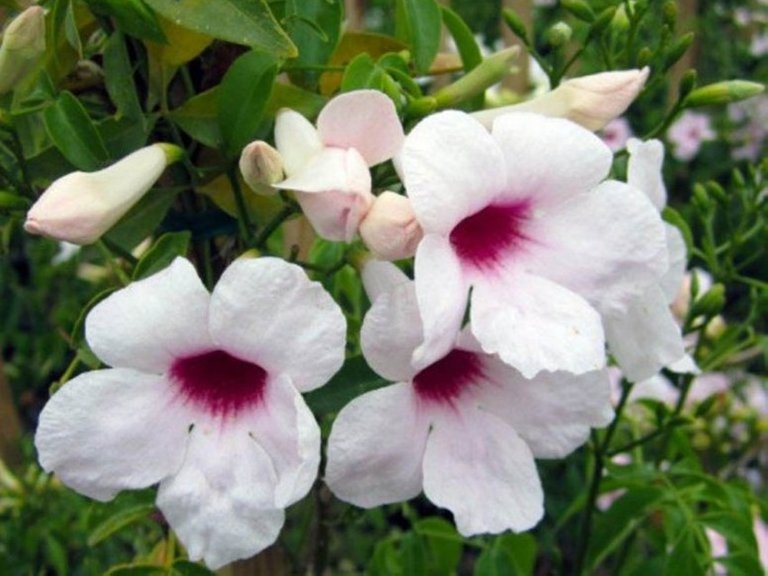
Recommendation: Plateau (cold weather)
Pot between 20-30 cm (medium)
Growing media using ordinary soil or humus soil
Illumination needs throughout the day
Medium water needs, flush 1x a day
Medium growth
Seedlings from stem cuttings
Moderate level of care difficulties
Source:
https://www.google.co.id/url?sa=t&source=web&rct=j&url=https://jualtanamanhias.net/tanaman-white-purple-bower-vine/&ved=2ahUKEwjioobtwOXdAhULSo8KHVMMCXcQFjALegQIBhAB&usg=AOvVaw1tEufsbtJtks6iNaoIN9Wd&cshid=1538406268778
Wonga-wonga Vine
The Wonga-wonga vine, (Pandorea pandorana), is a fast-growing Australian native climbing plant. It can be found in eastern Australia from Queensland to Tasmania growing vigorously over tall trees. It is also a spectacular garden plant.
Details
Common name: Wonga-wonga vine
Botanic name: Pandorea pandorana. This name is derived from the legend of the Greek goddess Pandora, because of the similarity of the seed capsules to Pandora’s Box.
Varieties: The species has heavy clusters of white, tubular flowers often tipped with purple dots. This form can be seen in bushland areas in eastern Australia. There are however several named varieties available including:
‘Snow Bells’ is a vigorous climber suited to screening. It has creamy white flowers in spring.
‘Golden Showers’ is a rich golden colour with brown tips to the flowers.
Other species: The other species, P. jasminoides, grows from the North Coast of New South Wales to Queensland and flowers almost continuously from August to January. There are several varieties of this species including, ‘Alba’, which has milky white flowers, and ‘Rosea’ which has a shell pink petals with a crimson throat.
Best climate: The wonga-wonga vinegrows well in all parts of Australia but needs a warm micro-climate in the colder mountain areas. P. jasminoides needs a warmer climate and grows well in Brisbane, Perth, Sydney and Townsville and in warm microclimates in Adelaide and Melbourne.
source
Wow the Wonga Wonga vine truly look beautiful in those shots really awesome the make the surrounding with their presence loved its name quite easy to remember too :D
Great photos. I like reading your blog. I take this opportunity to thank you for supporting my blog. Good luck to you and Love.
No problem, buddy ! We are here to help each other.
The Wonga-wonga vine, (Pandorea pandorana), is a fast-growing Australian native climbing plant. It can be found in eastern Australia from Queensland to Tasmania growing vigorously over tall trees. It is also a spectacular garden plant.
Details
Common name: Wonga-wonga vine
Botanic name: Pandorea pandorana. This name is derived from the legend of the Greek goddess Pandora, because of the similarity of the seed capsules to Pandora's Box.
Varieties: The species has heavy clusters of white, tubular flowers often tipped with purple dots. This form can be seen in bushland areas in eastern Australia. There are however several named varieties available including:
'Snow Bells' is a vigorous climber suited to screening. It has creamy white flowers in spring.
'Golden Showers' is a rich golden colour with brown tips to the flowers.
Other species: The other species, P. jasminoides, grows from the North Coast of New South Wales to Queensland and flowers almost continuously from August to January. There are several varieties of this species including, 'Alba', which has milky white flowers, and 'Rosea' which has a shell pink petals with a crimson throat.
source
Pandorea pandorana, Wonga Vine, is a member of the Bignoniaceae family. This woody scrambler or climber has long, twining branches with fawn coloured bark.
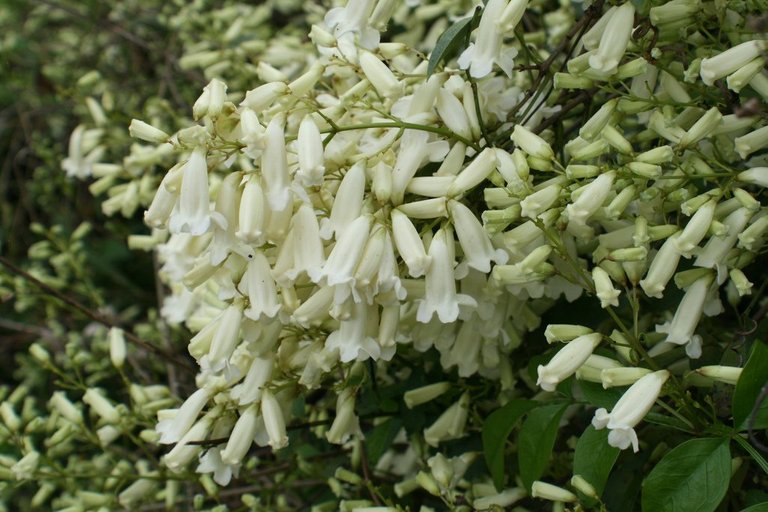
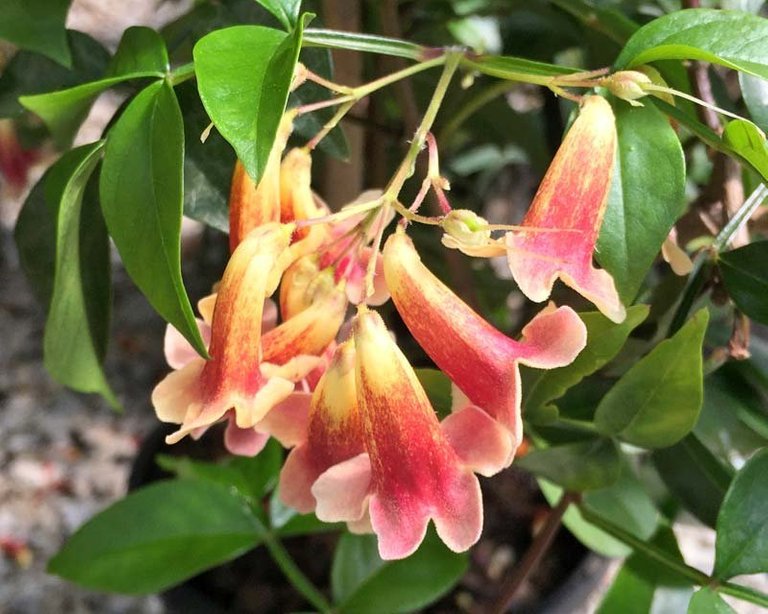
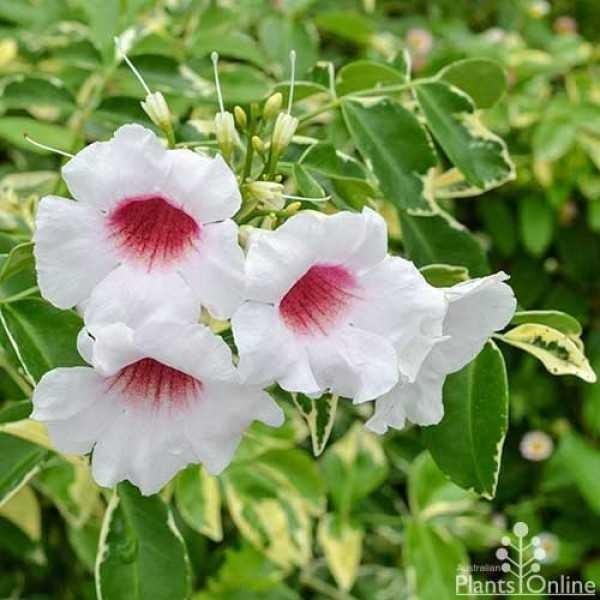

image source
The leaves are pinnate with from three to seven leaflets up to 15 centimetres long. Juvenile leaves have small, numerous leaflets giving plants, at this stage, a ferny appearance.
image source
Flowers are tubular, about two centimetres long, usually creamy-white with either brown or purple markings in the throat. Flowering is both profuse and conspicious in spring. The floral display is particularly eye-catching because the blooms are held in large terminal clusters.
image source
The capsules, that follow the flowers, are oblong; tapering at both ends and contain a number of winged seeds.
image source
There are a number of colour forms: “Snowbells” has pure white flowers and “Golden Showers” with distinctive yellow-bronze blooms are well known.
source
It seems to be like a good vine to to let crawl on a trellis for a shade and its attractive flowers attracts bees too @ctrl-alt-nwo
Very beautiful plant.
You always find such amazing flowers and trees,
very exotic and original.
And your photos are always very happy to consider @ctrl-alt-nwo
I found this video of these amazing flowers.
Next to them, even the birds sing )
Attractive flower. Looks like a humming bird favorite.
Binomial name: Pandorea pandorana


Synonyms: Tecoma australis
Common name: Wonga-wonga Vine, Wonga Vine, Spearwood Bush
Pandorea pandorana is a fast-growing highly variable species of a woody climbing vine, it is found across continental Australia, Indonesia, Papua New Guinea, the Solomon Islands, New Caledonia and Vanuatu. In New Zealand, the species has become naturalised within disturbed native vegetation growing on larger trees in forested habitats.
It has glossy green leaves arranged oppositely along the stem. The pinnate leaves are around 8–16 cm long and have 3–9 leaflets of varying widths. The juvenile leaves are finer and have serrated margins and more finely divided into 7–13 leaflets.
Flowering occurs in spring. The tubular or funnel-shaped flowers are highly variable in colour, ranging from cream-white or all-white to maroon-throated, burgundy or even yellow-orange. Flowering is followed in summer by 3–8 cm long and 1–2 cm wide oblong-shaped seed pods, which are initially bright green before turning brown and releasing numerous papery seeds around 1-1.5 cm (0.5 in) in diameter which is released in large quantities.
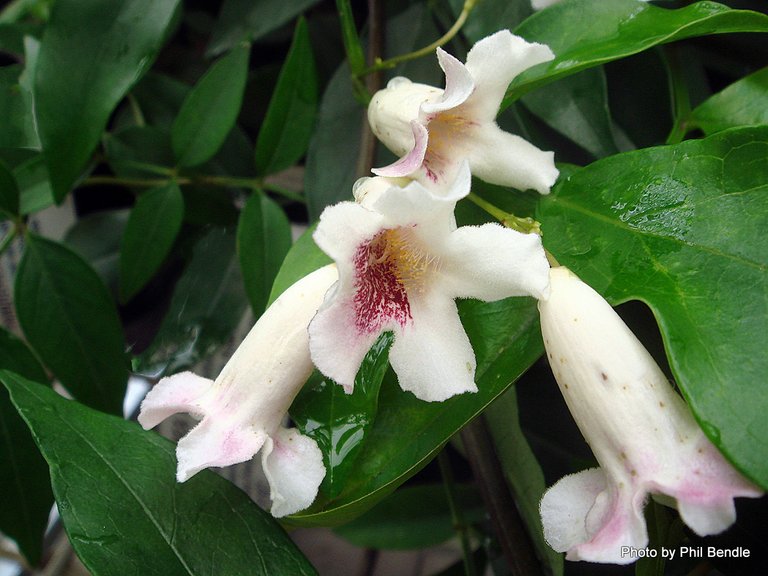
Common cultivars include:
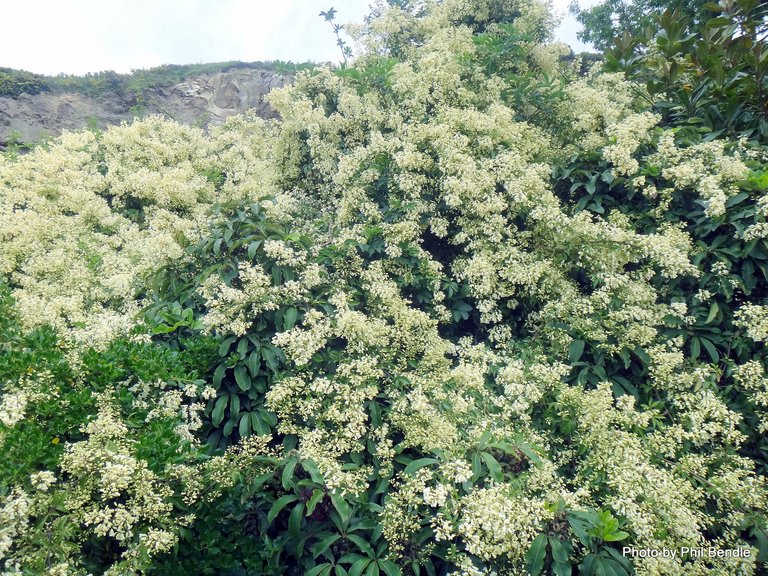 http://www.terrain.net.nz/friends-of-te-henui-group/weeds/pandorea-pandorana-wonga-wonga-vine.html
http://www.terrain.net.nz/friends-of-te-henui-group/weeds/pandorea-pandorana-wonga-wonga-vine.html
P. 'Golden Showers' is a long-flowering vigorous form with brown-tinted yellow flowers (photo below)
P. 'Ruby Belle' has a red-pink flower with cream throat.
P. 'Ruby Heart' has a cream-coloured flower with a deep ruby–maroon blotch at the throat.
P. 'Snowbells', also known as P. 'alba', is a vigorous cream-white flowered form, with profuse fragrant flowers.
Pandorea pandorana
Pandorea pandorana

An adaptable plant, wonga wonga vine announces spring with dense clusters of light yellow, tubular flowers at the tips of its twining branches. An evergreen vine native to moist forests of southwestern Melanesian islands and the eastern quarter of Australia, it also tolerates drier soils in another native pocket in central Australia's Outback.
Foliage has two forms: juvenile foliage is fern-like with deep finger-like lobes and matures to long, oval leaflets. From late winter and into spring, tubular, creamy light yellow flowers line the youngest stems of the vines. Each flower has spreading lobes and are spotted and streaked with purple-red in the throat. Sometimes flowering extends into the summertime. Winged seeds are released from the plump, boat-like fruits that follow the blooms.
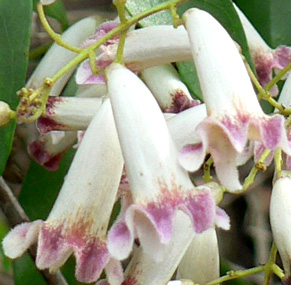
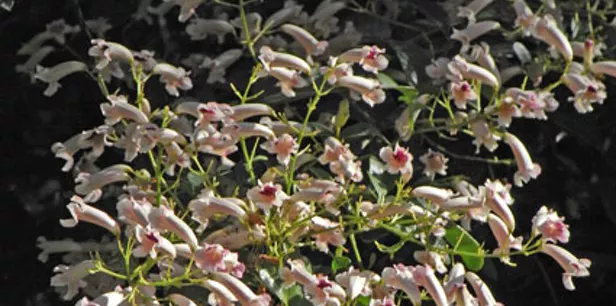
Grow wonga wonga vine in fertile, moist to dry, well-draining soils in full to partial sun. In hottest climes, provide partial shade. This species tolerates repeated winter frosts quite well. Vigorously growing, support is needed for this large climbing vine. Often it can reach the canopy tops of large trees. Use it as a large vine specimen on a sturdy arbor or allow it to climb into a specimen tree, where the vine's flowers will illuminate the tree canopy. Selection 'Snowbells' blooms in white, 'Golden Showers' display flowers of yellow and bronze. Variegated leaves are a hallmark of 'Charisma'.
References123 4
Wonga Wonga Wine is a beautiful and amazing plant. The botanical name of this plant is Pandorea pandorana is a family of Bignoniaceae which is also known as Pandorea Australis, Tecoma Australis.
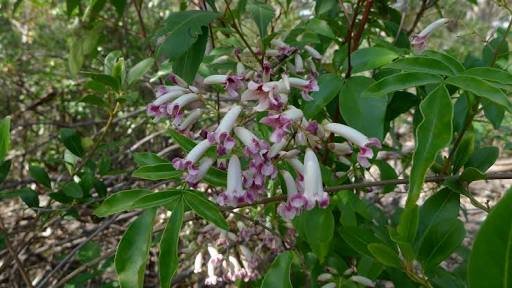.jpeg)
This plant comes from New Guinea, Australia.
This plant is also known as a tough climber with stems that become wood as adults.
The leaves have 5-7 (sometimes 3 or 9) leaflets that are narrow, oval, shiny, and hairless (15-60 x 7-40 mm).
Produces fragrant tubular flowers (length 17-23 mm) that are white or creamy on the outside, and cream or dark red or red patches inside.

Source
Botanical Name: Pandorea pandorana Snowbells
Common Names: Wonga Wonga Vine , Snowbells Wonga Vine
Foliage Type: Evergreen
Native Yes
Plant Type: Climber / Creeper
Plant Habit: Climbing / Twining
Typical Availability Medium
Description:
A Vigorous and hardy native climbing vine ideal for planting along a fence or support structure. The foliage is glossy green with fragrant white trumpet flowers appearing in abundance through Spring, Summer and Autumn. Adds a very pretty tropical display to the garden as well as being very hardy and easy to maintain.
source
love these flowers. just 3 more weeks and I´m back in Australia. Can´t wait to smell all these flowers.
These don't smell, but others do !
Nice flowers! Enjoy spring days there, it's getting cold in Belgium now.
details you gave it's speaking about everything, and pictures are showcasing everything. Amazing plant and if we see this plant while walking then for sure it's charm will stop us to explore it's beauty.@ctrl-alt-nwo, First of all whatever
And in my opinion this is Artistic plant that's why this plant can produce different colourful flowers. And literally speaking if we imagine breathtaking greenery and flowers around us, that natural essence will give the experience of Paradise.
Thank you so much for your kind support. Wishing you an great day and stay blessed. 🙂
Privacy plant-I like how it sounds :-)
More than the appearance of it I do like the name of it ;)
While it looks beautiful and it is pretty similar to Tuberose as well.
Wonga-wonga Vine, Wonga Vine, Spearwood Bush is the common name of this flower.

This plant develops very fast and has shiny green leaves arranged opposite along the stem.
In addition, the leaves pinnate around eight to 15 and cm and vary in width. Young leaves are smoother and have jagged and finer edges.
The flowers are funnel shapes and vary in color, ranging from beige, white, maroon-throated, burgundy or even yellow-orange.
Source:
https://www.google.co.id/url?sa=t&source=web&rct=j&url=http://www.terrain.net.nz/friends-of-te-henui-group/weeds/pandorea-pandorana-wonga-wonga-vine.html&ved=2ahUKEwiZ7ceDzuXdAhWJMY8KHfSOALAQFjAQegQIAhAB&usg=AOvVaw0TlzB7X1UmN-uBgllthbrv
Wonga Wonga Vine
Family: BIGNONIACEAE
Genus: Pandorea
Species: pandorana Cultivars
Vigorous, fast-growing climbers with shiny, green leaflets, woody older stems and clusters of narrow, tubular, bell flowers in winter and spring. Plants can climb as high as 6 metres and have a tendency to thicken by climbing over themselves. Prune after flowering.

Cultivars include 'Golden Belle' (yellow gold flowers), 'Golden Showers' (yellow gold flowers), 'Lemon Bells' (lemon flowers), 'Ruby Belle' (cream and ruby-red flowers), 'Snowbells' (creamy white flowers) and 'Springbrook Belle' (cream with purple throat). May spread in certain circumstances.
Pandorea pandorana is often known as the "Wonga wonga vine". It hails from Australia where it forms a large vigorous, evergreen twiner. When growing in the wild it flowers early in the year, typically April and May.
Here in the UK it can flower through until August and September, depending upon its position. It can form an excellent conservatory subject as it generally thrives in pots. The tubular flowers appear in multiple bunches and they are cream white, with pinky red markings in the throat. They also have a light scent.
Evergreen, woody climber.
Can be moved outdoors during summer in a sheltered situation.
Can cope with full sun to partial shade.
Likes regular and reliable watering until established.
Drought-tolerant once established.
Ultimate height: up to 5m.
Sold in a 19/20cm pot.
source